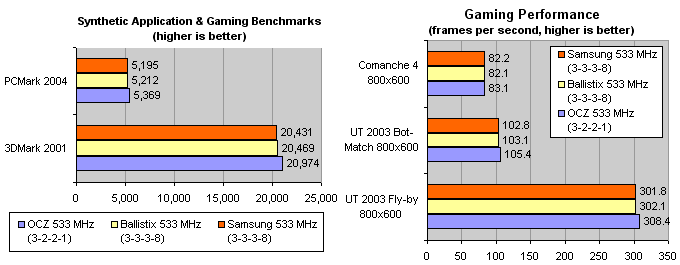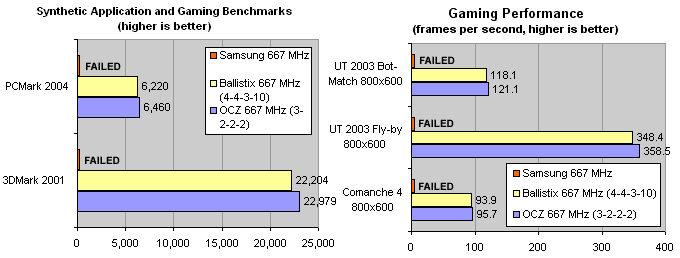|
|
Advertisement:
|
|
DDR2 Takes Off: OCZ PC2-4200 Rev.2 and ASUS P5AD2-E |
|
Join the community - in the OCAU Forums!
|
Test Settings, Results at 533MHz and 667MHz
For testing the performance of the 3 DDR2 products we used an assortment of well-known benchmarking software for measuring memory bandwidth, application performance, and gaming:- SiSoft Sandra 2004, ScienceMark 2.0, and Everest (Memory bandwidth and latency)
- Super PI (Mathematical calculation to measure system performance)
- PCMark 2004 Pro (Scripted applications to measure system performance)
- 3DMark 2001 (Synthetic gaming benchmark)
- Comanche 4 (Game)
- Unreal Tournament 2003 (Game)
PERFORMANCE AT 533 MHz
With our first test run we intended to find out how OCZ PC2-533 Rev2 is performing at its specified stock frequency of 533 MHz and default timings of 3-2-2-8. For a fair comparison we wanted to run the products at the best of their abilities and not at their manufacturer specified defaults. All 3 products in this test were therefore tested at the most aggressive timings that were possible at 2.2 volt and that did not compromise stability. At 533 MHz Ballistix and Samsung were in fact running at much better timings than their specified defaults. The OCZ PC2-4200 Rev 2, already much more aggressively timed at default than the competition, allowed us only to lower the less important TRAS value from 8 to 1.- OCZ: Default timings: 3-2-2-8, 533 MHz test timings: 3-2-2-1
- Ballistix: Default timings: 4-4-4-10, 533 MHz test timings: 3-3-3-8
- Samsung: Default timings: 4-4-4-10, 533 MHz test timings: 3-3-3-8


Our test results show that bandwidth, productivity and gaming are around 2%~3% better with OCZ PC2-4200 Rev 2 running at 3-2-2-1 than with Ballistix and Samsung running at 3-3-3-8. Such small differences are visible in benchmarks only and not actually noticeable when a user is running applications. But they once more confirm the already well-known fact that aggressive memory latencies enhance system performance. OCZ PC2-4200 Rev 2 is therefore the clear winner at 533 MHz.
PERFORMANCE AT 667 MHz:
667 MHz is currently the highest JEDEC approved DDR2 frequency. OCZ and Samsung are specified to run at 533 MHz, while the Ballistix is 667 MHz by default - so in the latter case we are not really overclocking. The Pentium 4 Extreme Edition we used is specified to run at 13 x 266 MHz = 3,460 MHz. This CPU would of course not run air-cooled at 13 x 333 MHz = 4,329 MHz. We therefore lowered the CPU multiplier to 12x, so that our 3.46 GHz EE was running at 12 x 333 MHz = 3,990 MHz, the system bus at 4 x 333 MHz = 1,332 MHz and the memory at 2 x 333 MHz = 666 MHz. Because the CPU and memory base frequency were both set to 333 MHz, the memory controller was synchronously communicating between the CPU and the memory. This is ensuring an optimal performance environment.
Samsung DDR2 PC2-4200 could not run at 667 MHz. Even when the modules were running at 2.2 volt the system was not 100% stable. We therefore show only the bandwidth result but no application based benchmarks for this product. Ballistix PC2-5300 is specified to run at 667 MHz with latency timings of 4-4-4-10 and it did this without any problem - we could actually run it at slightly better timings of 4-4-2-10. OCZ PC2-4200 Rev 2 however gave a truly amazing performance, running at 667 MHz with timings of 3-2-2-2, unprecedented for DDR2. We are not aware of any other DDR2 product that can do this.


As to be expected the OCZ modules outperformed the Ballistix modules in all tests. The OCZ performance lead over Ballistix we already saw at 533 MHz is naturally even bigger at 667 MHz, because the Ballistix timings had be increased (slowed) in comparison to 533 MHz so that it would run stable at 667 MHz. The OCZ memory delivered around 10% more bandwidth than Samsung and still 8% more bandwidth than Ballistix. In gaming and applications the system performed between 3% and 5% better with OCZ PC2-4200 Rev 2 than with Ballistix. The fact that Ballistix PC2-5300 is rated to run at 667 MHz and that OCZ PC-2 4200 Rev 2 is overclocked when running at 667MHz and yet performing much better than Ballistix, shows that manufacturer ratings have sometimes little meaning. The excellent OCZ results at 667 MHz achieved thanks to the unprecedented aggressive timings of 3-2-2-2 also show that this memory is indeed a next generation DDR2 product.
|
|
Advertisement:
All original content copyright James Rolfe.
All rights reserved. No reproduction allowed without written permission.
Interested in advertising on OCAU? Contact us for info.
|

|


